Key takeaways:
- DIY water filtration offers cost savings, control over water quality, and an educational experience by experimenting with different materials.
- Key materials include activated charcoal, gravel, sand, and cotton fabric, each serving a specific purpose in the filtration process.
- Success in water filtration relies on clean materials, proper layering, and allowing sufficient time for water to flow slowly through the system.
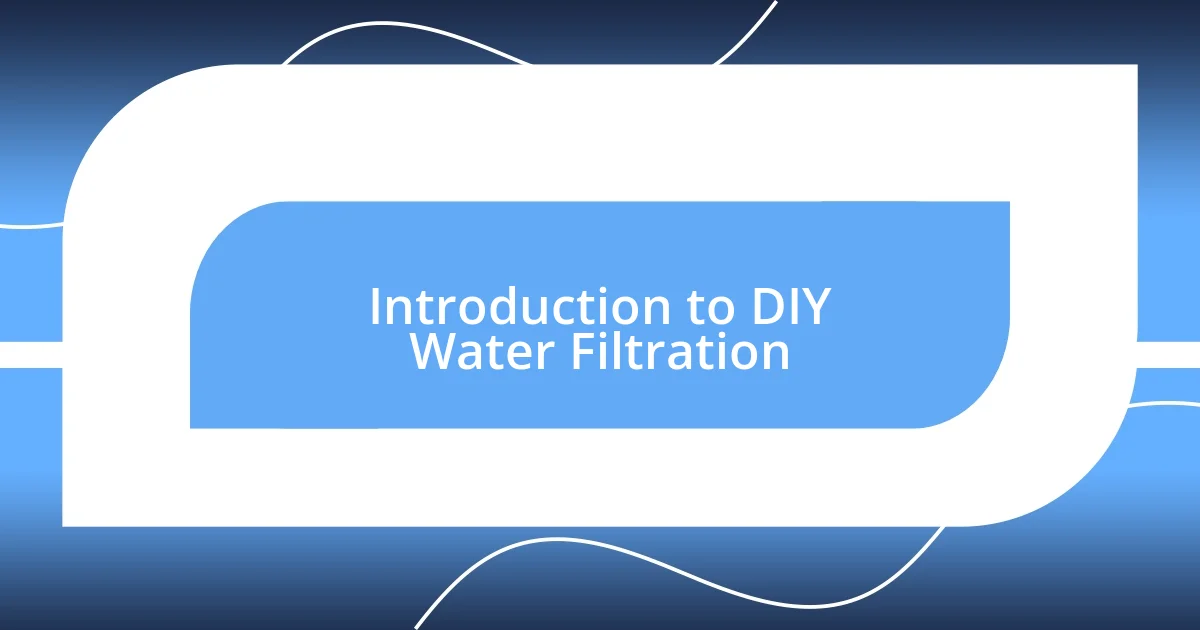
Introduction to DIY Water Filtration
DIY water filtration might sound like a simple task, but it’s an empowering journey I didn’t truly appreciate until I dove into it myself. As I began experimenting with various materials and methods in my kitchen, I found a sense of control over something fundamental to life: clean water. Have you ever considered how much we take for granted in our daily lives? It was a humbling experience to realize that with just a few supplies, I could create a system that not only saved money but also offered peace of mind.
One of the most fascinating aspects of DIY water filtration for me was the discovery of different filtration methods, such as activated charcoal and sand layers. Each method had its unique qualities, and I remember the moment I first tested my homemade filter. The transformation of murky water into something clearer felt like magic, and I was hooked! Isn’t it interesting how something as mundane as water can become a subject of exploration and wonder?
As I researched and crafted my filtration systems, I encountered numerous challenges that tested my patience and creativity. There were times when I overshot the design, and my filters turned into elaborate contraptions that simply didn’t work. In those moments, I learned the true value of persistence and experimentation. Isn’t it amazing how every failure paved the way to a deeper understanding of the process?
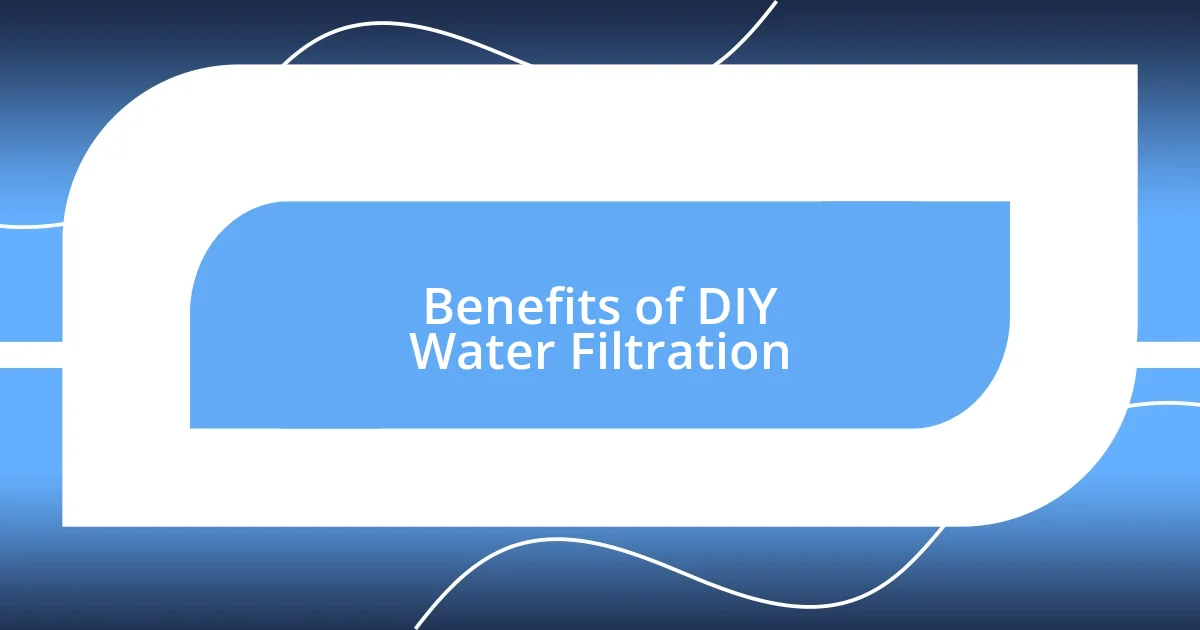
Benefits of DIY Water Filtration
One of the most significant benefits of DIY water filtration is the cost-effectiveness it brings. I recall calculating the expenses of store-bought filtered water and feeling shocked at how quickly those costs added up. With my DIY system, I was able to create an efficient filtration process at a fraction of the price. The satisfaction of seeing my monthly expenses decrease while simultaneously improving my water quality was incredibly rewarding.
Here are some key benefits of DIY water filtration:
- Affordability: DIY systems usually require inexpensive materials that you can find around the house or at local stores.
- Control over Quality: I felt more in charge of what went into my filtration system, ensuring it met my purification standards.
- Customization: I discovered I could tailor my filter to specific needs, like removing certain contaminants that were more prevalent in my area.
- Sustainability: Using recycled materials in my filtration system made me feel like I was contributing positively to the environment.
- Educational Experience: Experimenting with different methods taught me about water quality and the science behind filtration in a hands-on way.
The empowerment gained from creating a water filtration system can’t be overstated. Not only did I gain a practical skill, but I also developed a deeper connection to the water I consumed. There’s something deeply fulfilling about knowing the source of your clean water, especially in a world where accessibility can be a challenge.
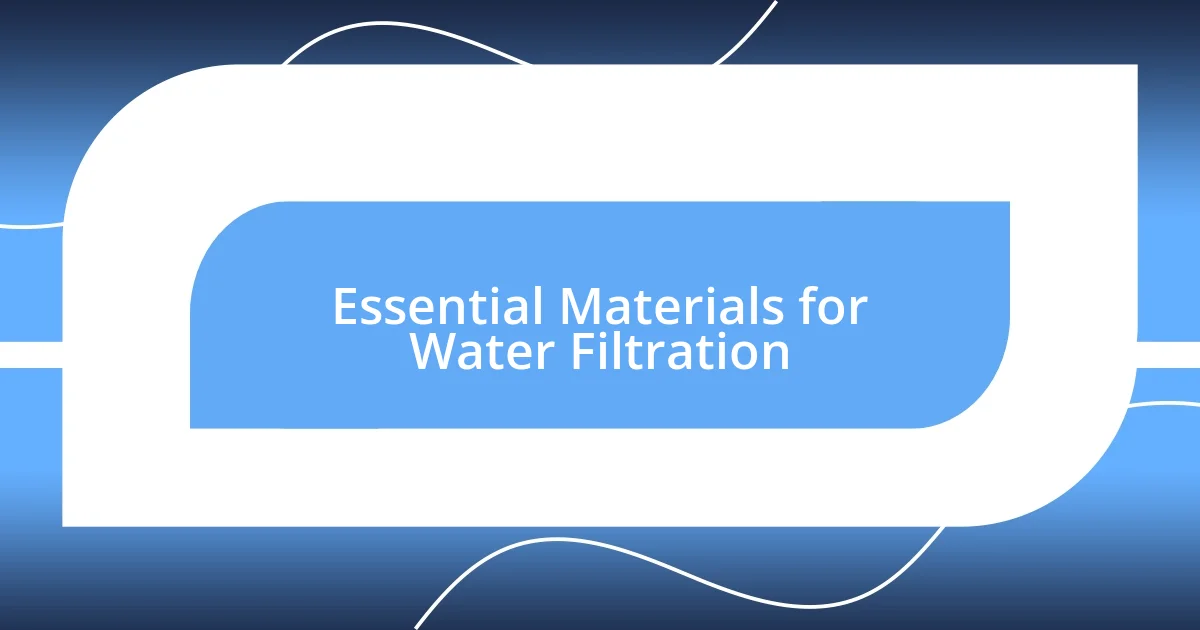
Essential Materials for Water Filtration
When diving into DIY water filtration, I quickly realized the importance of specific materials that shaped my experience. For instance, I started with activated charcoal, which amazed me with its ability to absorb impurities. I remember pouring water through this black substance and watching it transform—it was like witnessing a little miracle! Another staple is gravel, an often-overlooked material that serves as a preliminary filter to catch larger particles. It’s easy to underestimate how a simple layer of gravel can greatly enhance the filtering process.
As I built my systems, I discovered sand was an essential component, acting like a natural sieve. I recall the day I mixed different textures of sand to see if it made a difference. Surprisingly, it did! The finer sand filtered out even more debris, making the water clearer. It was satisfying to see how each layer in my filter played a unique role in the purification process, creating a symphony of materials working together for a common goal: clean drinking water.
Lastly, I found cotton fabric to be invaluable for capturing the tiniest sediment. I initially used an old t-shirt, which led to some amusing moments as I tried to filter the water. It made me appreciate how everyday items can contribute to such an essential task. The journey showed me just how interconnected these materials are and how, with a few simple elements, I could harness the power of nature to ensure my family had access to clean water.
| Material | Function |
|---|---|
| Activated Charcoal | Absorbs impurities and contaminants. |
| Gravel | Catches larger particles as a preliminary filter. |
| Sand | Acts as a sieve for smaller debris. |
| Cotton Fabric | Filters out sediments for clearer water. |
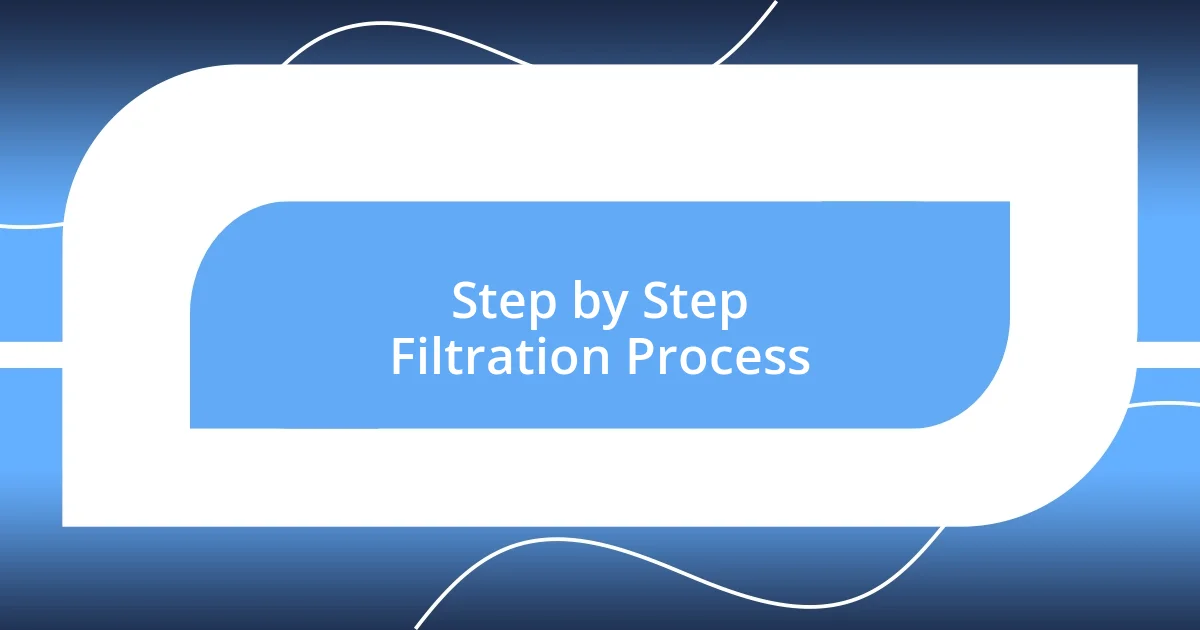
Step by Step Filtration Process
The filtration process I crafted was straightforward yet effective. I started by layering materials in a large container—gravel at the bottom, followed by sand, and then activated charcoal. I distinctly remember looking at my creation and wondering how all these simple elements could yield clean water. It felt like I was a part of something bigger, almost an alchemist of sorts!
Next, I poured my contaminated water slowly through the layers, excited yet nervous about the outcome. The anticipation was palpable—would I really be able to turn murky water into something drinkable? Each drop that trickled through reinforced the idea that patience is key. I can’t tell you how gratifying it was to see the clear water collect at the bottom, a testament to the effectiveness of my DIY approach.
Finally, I let the filtered water sit for a while and took a moment to reflect. I was proud of what I had accomplished. It made me wonder—how many people overlook the importance of water filtration in their daily lives? I learned that engaging with this process not only heightened my awareness of water quality but also deepened my appreciation for the simple act of drinking water. Each sip now felt like a victory!
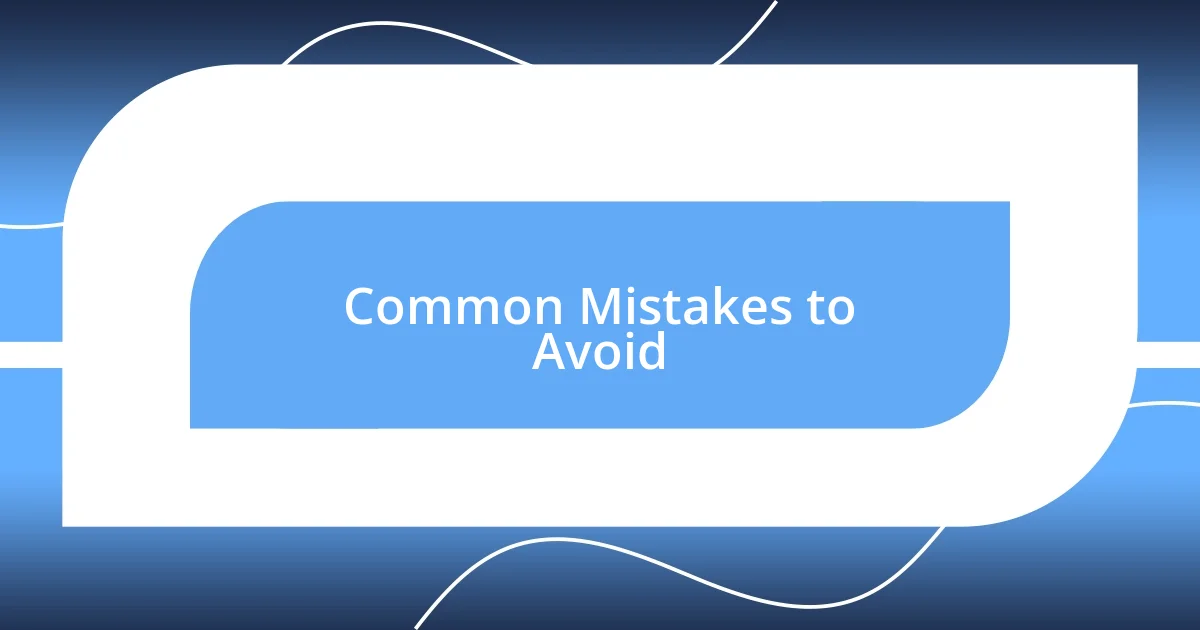
Common Mistakes to Avoid
When I first started my DIY water filtration project, I underestimated the importance of using clean materials. I remember grabbing some old gravel from my garden, thinking it wouldn’t matter much. What I discovered was that impurities from unclean materials easily contaminated the water instead of purifying it. Trust me, you don’t want to drink something that you intended to cleanse!
Another pitfall I fell into was skipping the layering process. Eager to see results, I thought I could just dump everything in a single layer. The water didn’t filter properly, and I faced a bit of a messy situation. I learned that each component serves a specific purpose, and without the right order, the system just doesn’t work. It’s like trying to bake a cake without following the recipe—you might end up with a gooey mess!
Lastly, timing is crucial. I once got impatient and filtered the water too quickly, which left me with murky results. It taught me that good things take time, and that patience in this process yields clear rewards. Next time I went through it, I allowed the water to flow more slowly, and the difference was incredible. Isn’t it fascinating how a little patience can lead to such purity?
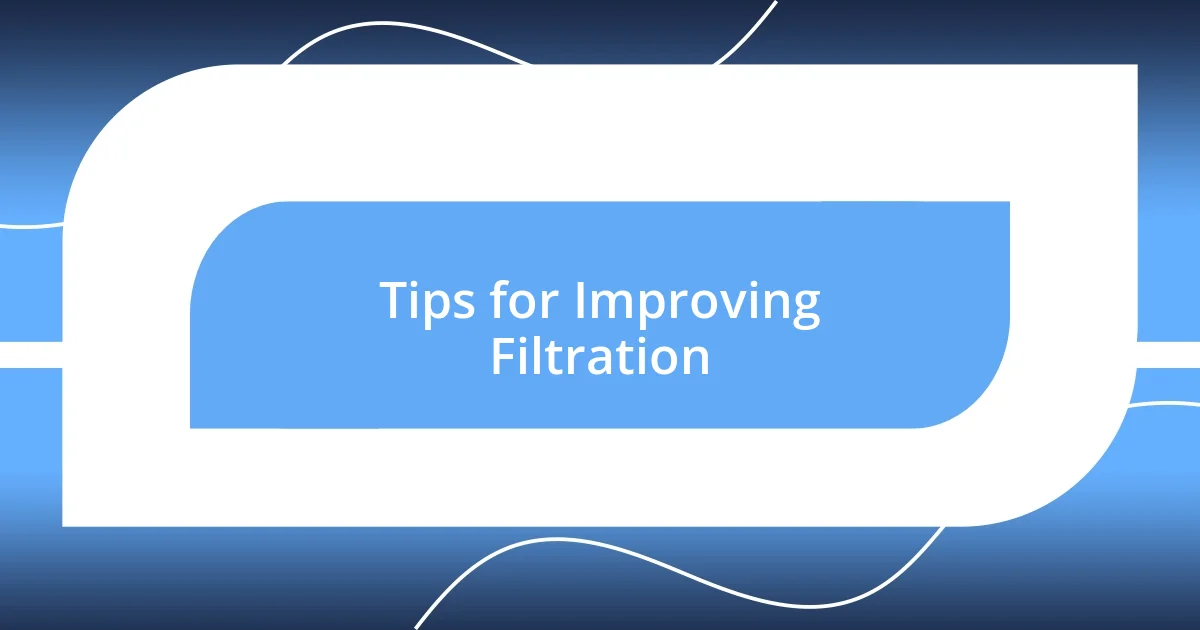
Tips for Improving Filtration
One effective tip I found invaluable is to regularly replace your filtration materials. I remember the first time I thought I could use the same crushed charcoal indefinitely. After several uses, my filtered water started to taste a bit off, which left me puzzled. This experience taught me that over time, filtration materials can become saturated with impurities. It’s like trying to clean a dirty sponge; eventually, it just needs replacing. I learned to set reminders to refresh my materials, ensuring that each batch of filtered water tasted fresh and clean.
Don’t overlook the importance of pre-filtering your water, especially if it contains larger debris. I’ll never forget the time I poured a bucket of collected rainwater directly into my filtration system without straining it first. The results were somewhat disastrous, as leaves and twigs clogged my beautiful creation. Now, I always take a moment to strain the water first. It’s a quick step that makes a world of difference, preventing clogs and ensuring that the finer filtration materials can do their job effectively. Have you ever skipped steps in projects, thinking they were unnecessary? I learned the hard way that even the small steps matter!
Lastly, pay attention to your water flow rate. I recall a moment when I got overly excited and rushed the process, only to witness a waterfall of murky water spill over the sides of my container. What I realized was that allowing water to flow too quickly can disrupt the filtration layers and diminish the overall effectiveness. By slowing down the pour, I’ve seen a significant improvement in water clarity. This taught me an essential lesson: sometimes, in the pursuit of speed, we sacrifice quality. Isn’t it interesting how this simple adjustment can lead to much better results?
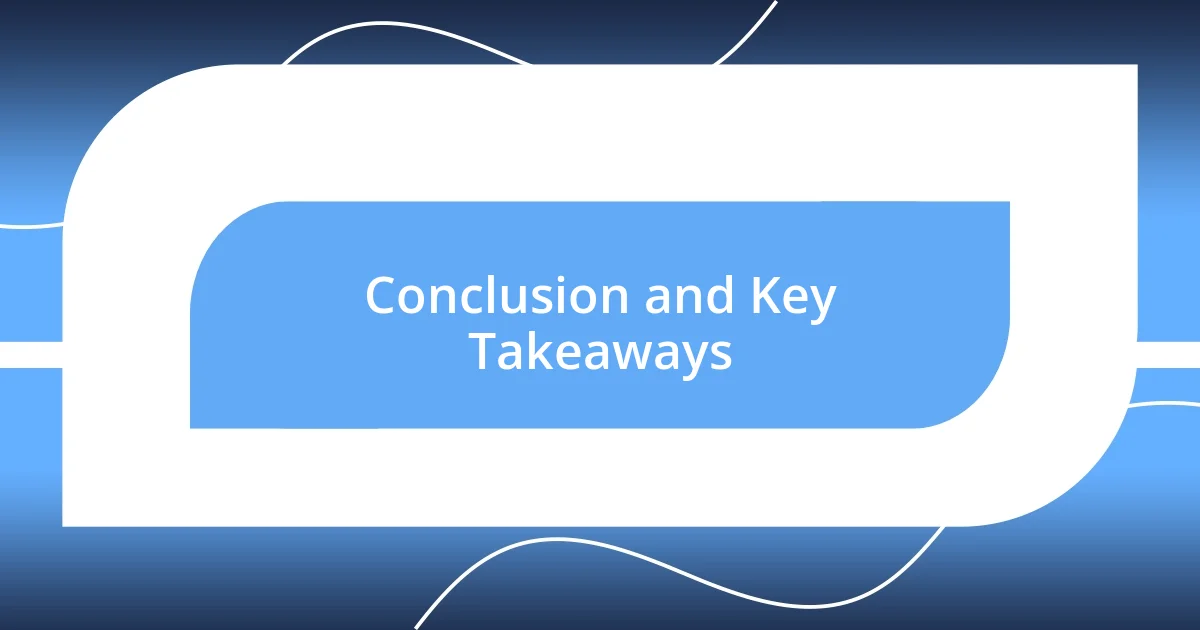
Conclusion and Key Takeaways
Reflecting on my DIY water filtration journey, I’ve recognized that preparation truly makes a difference. The cleanliness of your materials isn’t just a minor detail—it’s foundational. I remember the disappointment of realizing that my hastily chosen gravel not only failed to filter but also introduced unexpected flavors. Have you ever overlooked an important detail thinking it wouldn’t matter? It’s surprising how often that little oversight can derail your efforts.
Another key takeaway is the layering process. After my initial clumsy attempt, I appreciated how each layer plays a vital role in filtering out different impurities, just like how a symphony requires each instrument to contribute to the harmony. I can vividly recall the moment I restructured my setup and saw the difference in clarity. It struck me that sometimes, just like in life, taking a thoughtful approach yields the best results.
Lastly, I’ve come to cherish the value of patience in this process. Rushing through filtration has led me to some unsatisfactory outcomes. I learned firsthand that letting the water flow slowly fosters better filtration, leading to surprisingly clearer results. Doesn’t it remind you that sometimes, the best outcomes come when we slow down and allow processes to unfold? In my experience, whether it’s in water purification or other ventures, a little patience can lead to more rewarding outcomes.












